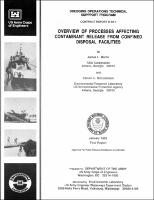Please use this identifier to cite or link to this item:
https://hdl.handle.net/11681/4737| Title: | Overview of processes affecting contaminant release from confined disposal facilities |
| Authors: | Martin, James Lenial, 1947- McCutcheon, Steve C. |
| Keywords: | Confined disposal facilities (CDF) Spoil banks Contaminated sediment Dredged material Dredging spoil Contaminant modeling Environmental chemistry Dredging Operations Technical Support Program (U.S.) |
| Publisher: | U.S. Army Engineer Waterways Experiment Station |
| Series/Report no.: | Contract Report (Dredging Operations Technical Support Program (U.S.)) ; no.Contract Report D-92-1 |
| Abstract: | Confined disposal facilities (CDFs) are widely used for the disposal of dredged material from Corps of Engineers maintenance dredging projects along the Atlantic and Gulf coasts and waterways and harbors in the Great Lakes. CDFs are a less common disposal alternative along the Pacific coast and inland river systerns. When contaminated dredged material is placed in a CDF, there is a potential for contaminant mobilization and release from the CDF by a variety of physical, chemical, and biological processes. This report provides an overview of the processes affecting mobilization and release of contaminants from CDFs and the potential applicability of multimedia models for prediction of contaminant release. Processes affecting release from in-water CDFs are emphasized, although many of the processes discussed are applicable to nearshore and upland CDFs. Processes affecting contaminant release are complex, involving a variety of chemicals and operational and design considerations. Many of the important processes are reasonably well known. Laboratory column settling and elutriate techniques have been developed to estimate solids and contaminant concentration in water directly released during hydraulic disposal operations. Predictive techniques for other processes are not as available. Processes affecting contaminant transport and fate have received considerable attention and have been incorporated into a number of models, primarily for surface waters. Relatively few attempts have been made to consolidate these process descriptions into a unified mechanistic modeling approach applicable to CDFs. Although the limited modeling studies on CDFs have proved valuable in estimating losses in some cases, these approaches are largely unvalidated. No database of sufficient detail to evaluate their general applicability to CDFs presently exists. Some combination of mechanistic modeling and laboratory techniques presently available may be sufficient to provide reconnaissance-level evaluations of CDF containment effectiveness. However, additional model and laboratory test development as well as supporting field studies are needed to develop fully predictive tools. Such tools would provide cost-effective methods for evaluating CDF design and operational alternatives. |
| Description: | Contract Report |
| Gov't Doc #: | Contract Report D-92-1 |
| Rights: | Approved for public release; distribution is unlimited |
| URI: | http://hdl.handle.net/11681/4737 |
| Appears in Collections: | Contract Report |
Files in This Item:
| File | Description | Size | Format | |
|---|---|---|---|---|
| 11619.pdf | Contract Report D-92-1 | 4.12 MB | Adobe PDF |  View/Open |